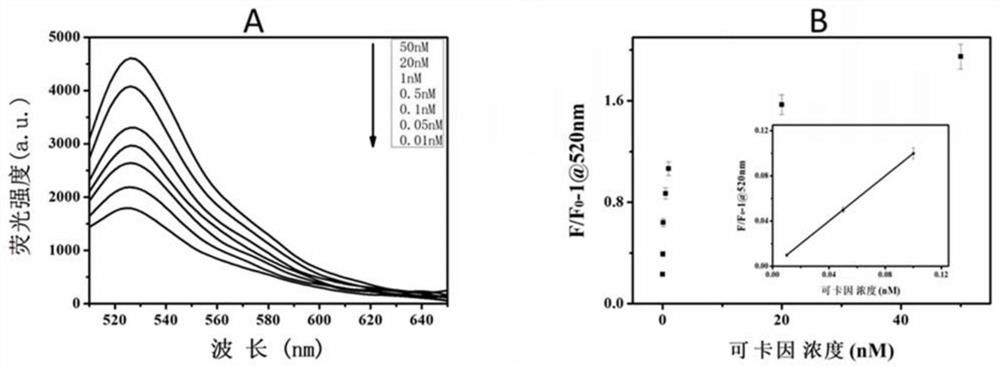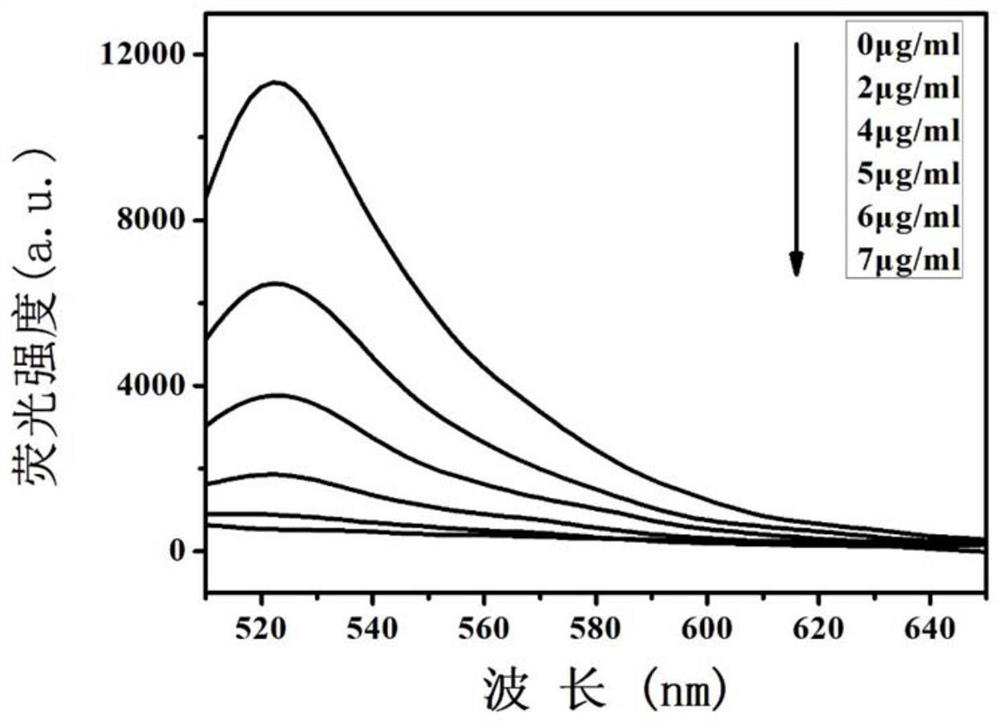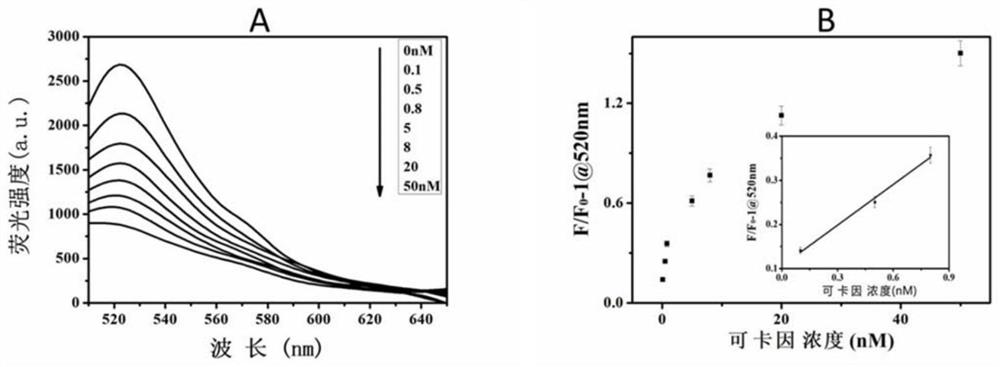A method for detecting cocaine based on polycytosine-based nucleic acid aptamers
A nucleic acid aptamer, polycytosine technology, applied in the field of biotechnology detection, can solve the problems of strong background signal, low detection limit, complicated operation, etc., and achieves the effects of simple method, reduced synthesis cost, and improved detection sensitivity
- Summary
- Abstract
- Description
- Claims
- Application Information
AI Technical Summary
Problems solved by technology
Method used
Image
Examples
Embodiment 1
[0025] Poly-C modification is carried out on the cocaine nucleic acid aptamer fragment, and the cocaine nucleic acid aptamer fragment sequence after Poly-C modification is shown in SEQ ID NO.1, which is: 5'-CCCCCCCCCCCCCCCCATAGGGAGACAAGGATAAATCCTTCAATGAAGTGGGTCTCCC-3, the sequence is composed of Shanghai Sangon synthesized and modified FAM fluorescence (FAM-modified DNA has a characteristic absorption peak at 520nm), and then added phosphate-buffered saline (PBS) to configure the PBS buffer of Poly-C cocaine nucleic acid aptamer with a final concentration of 10 μM , stored at -20°C;
[0026] Add 5 µg / ml GO to 600 µL of PBS buffer containing 20 nM Poly-C cocaine aptamer, and react at room temperature for half an hour to obtain the Poly-C-GO cocaine aptamer;
[0027] Add Tween 20 with a concentration of 0.05% to the Poly-C-GO cocaine nucleic acid aptamer solution containing 6 µg / mLGO and 20nMPoly-C modification, and measure its fluorescence intensity after reacting at room tempe...
Embodiment 2
[0030] A method for detecting cocaine based on a nucleic acid aptamer of polycytosine, comprising the following steps:
[0031] (1) Poly-C modification was performed on the cocaine nucleic acid aptamer fragment. The sequence of the poly-C modified cocaine nucleic acid aptamer fragment is shown in SEQ ID NO.1, which was synthesized by Shanghai Sangong and FAMed Fluorescent modification (FAM-modified DNA has a characteristic absorption peak at 520nm), then add phosphate buffered saline (PBS) to configure the PBS buffer solution of Poly-C cocaine nucleic acid aptamer with a final concentration of 10 μM, and store at -20°C;
[0032] (2) Add 5 µg / ml GO to 600 µL of PBS buffer containing 20 nM Poly-C cocaine aptamer, and react at room temperature for half an hour to obtain Poly-C-GO cocaine aptamer;
[0033] (3) Add Tween 20 at a concentration of 0.01% to the Poly-C-GO cocaine nucleic acid aptamer for modification, and perform fluorescence detection after 30 minutes of reaction at r...
Embodiment 3
[0037] Poly-C modification was performed on the cocaine nucleic acid aptamer fragment, and the nucleotide sequence of the cocaine nucleic acid aptamer fragment modified by Poly-C is shown in SEQ ID NO.1, and the sequence was synthesized by Shanghai Sangong and FAM Fluorescent modification (FAM-modified DNA has a characteristic absorption peak at 520nm), then add phosphate buffered saline (PBS) to configure the PBS buffer solution of Poly-C cocaine nucleic acid aptamer with a final concentration of 10 μM, and store at -20°C;
[0038] Add GO at concentrations of 0, 2, 4, 5, 6, and 7 μg / mL to 600 µL of PBS buffer containing 20 nM Poly-C cocaine nucleic acid aptamer, react at room temperature for half an hour, and measure the fluorescence intensity (a.u.) . figure 2 It is the comparison graph of fluorescence intensity after quenching of Poly-C cocaine nucleic acid aptamer by different concentrations of GO; figure 2 It can be seen that as the concentration of GO increases, the f...
PUM
 Login to View More
Login to View More Abstract
Description
Claims
Application Information
 Login to View More
Login to View More - R&D
- Intellectual Property
- Life Sciences
- Materials
- Tech Scout
- Unparalleled Data Quality
- Higher Quality Content
- 60% Fewer Hallucinations
Browse by: Latest US Patents, China's latest patents, Technical Efficacy Thesaurus, Application Domain, Technology Topic, Popular Technical Reports.
© 2025 PatSnap. All rights reserved.Legal|Privacy policy|Modern Slavery Act Transparency Statement|Sitemap|About US| Contact US: help@patsnap.com



